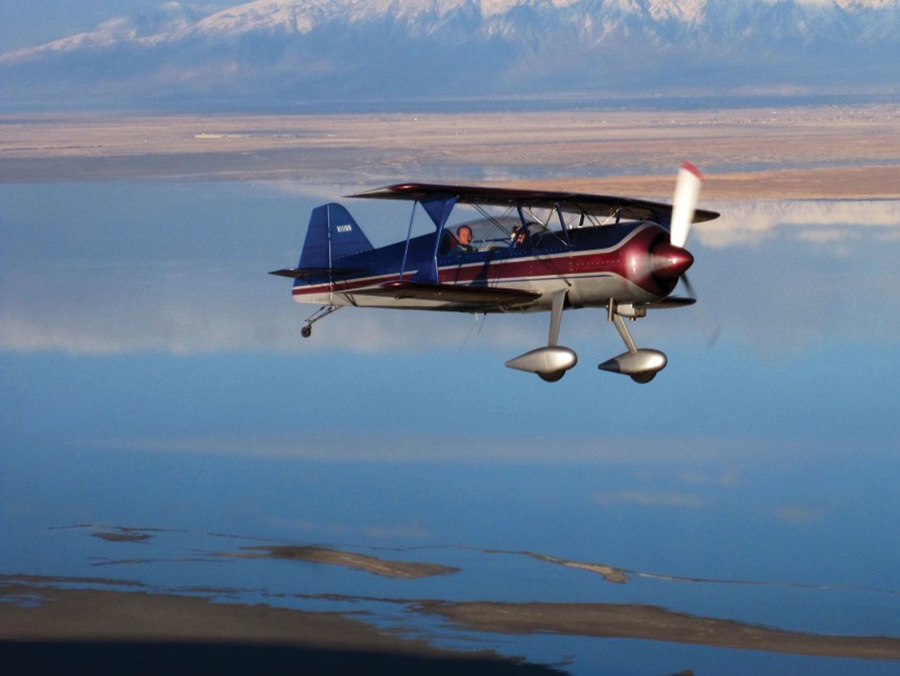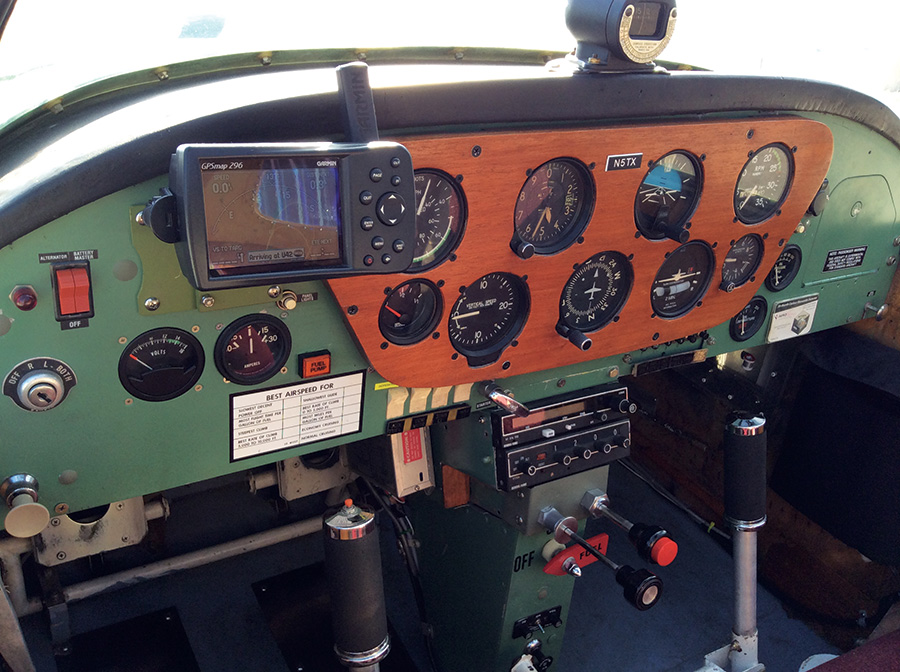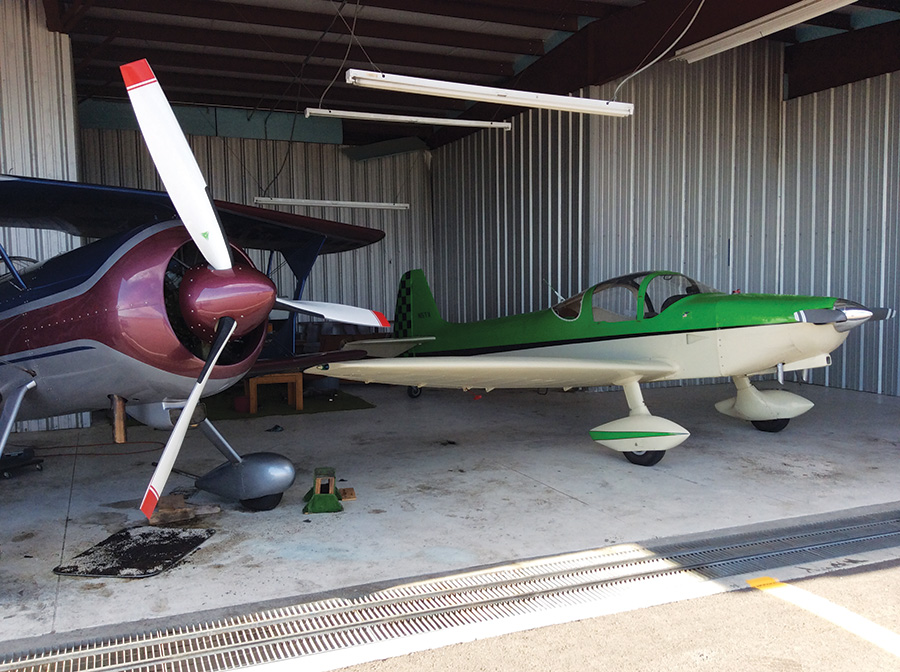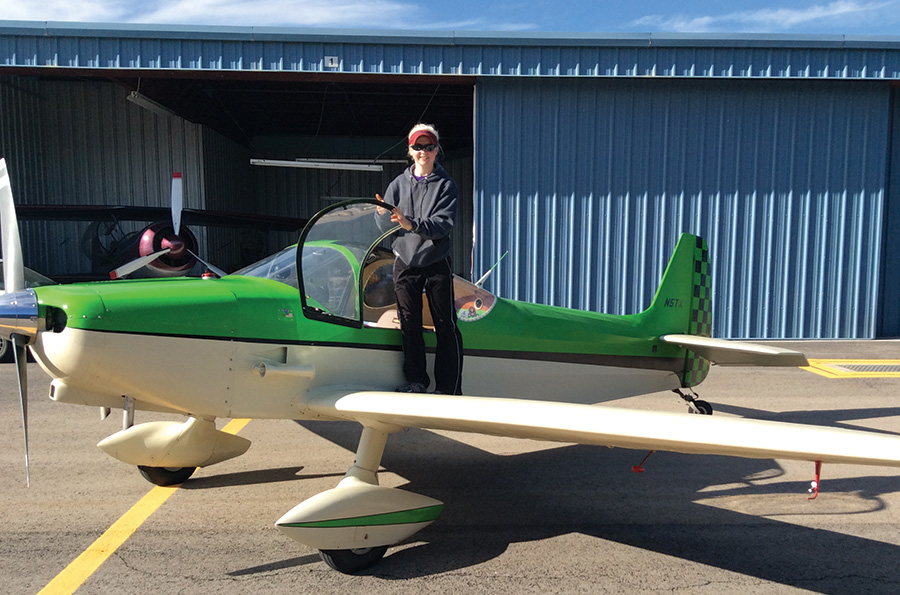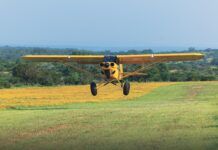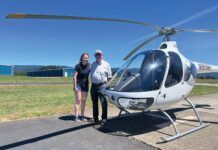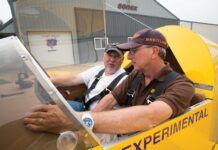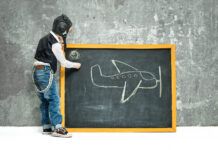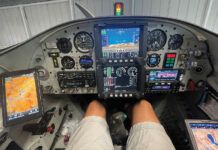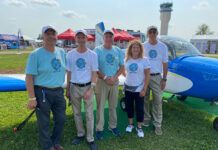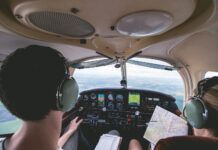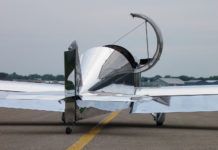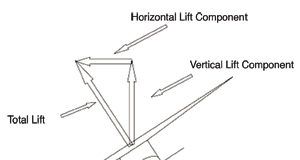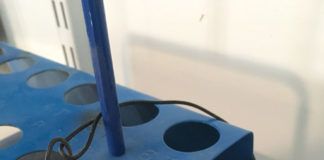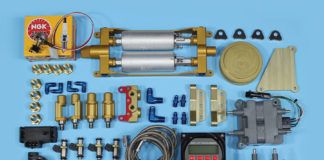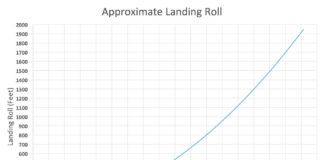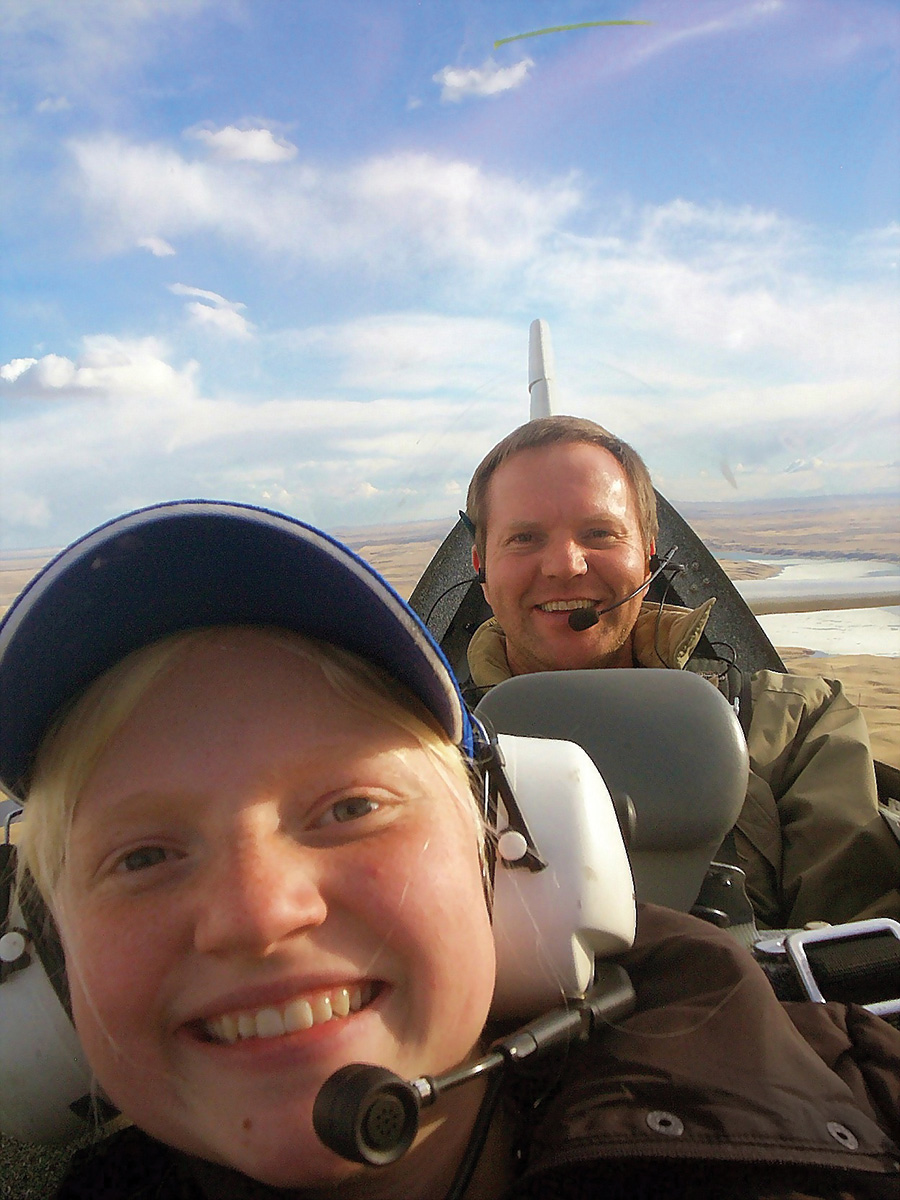
Parachutes make lousy seat cushions and mine bulged demonically as though filled with horseshoes and baseballs. I couldn’t move with seven seat belts ratcheting my holy buttocks to a point calculated for balance and easy reach of the flight controls. I love to fly, especially in this powerful biplane, but it makes little compromise for comfort.
Just ahead of me sits a bundle of enthusiasm. She’s earned an airplane ride, one of many, with patience, babysitting, and good behavior. We’ve been flying together for a few years now. It’s been awhile for this plane though, and Sarah has been anxious to get back in the cockpit. I check the usual parameters, glance around looking for other airborne traffic, verify we’re at a suitable altitude, and say, “Okay Sarah, it’s all yours.”
The next few minutes surprised me. The world flipped about like a toy in her hands, the plane rolling and looping effortlessly around like a happy monkey in a jungle canopy. She demonstrated remarkable skill, her maneuvers were smooth and correct, and she giggled like a fourteen year old girl. That flight, like every one, boasted a liberal salting of slow motion maneuvers. Imagine a 200 mph roller coaster that goes up and down a thousand feet at a time. Very fun, but I began to get tired. “Already?” she said, but 40 minutes quickly passed and we headed back for a landing.
An aerobatic machine is fun, but probably not the best ship in which to start training for your license.
Sarah has flown a number of airplanes, is very attentive to their details, and is a terrific traveling companion. She has flown all around the Wasatch front, north to Edmonton, BC, and recently across the continent to Quebec City.
Hard to believe all that came from a short airplane ride several years ago, when we floated a few things around the cockpit in zero G. I guess time really flies when you’re having fun.
She hopes to get a pilot license, but the cost has inflated well beyond reason. Despite her experience in various high-performance airplanes, none are suited for flight training. Certainly not the Pitts; it has no lights, no gyros and no forward visibility. Best to learn in a tailwheel airplane with a great forward view and slower reflexes. She could, of course, rent the local Cessna 152, but it failed to spark her imagination with its benign manners and $100 per hour price tag. I’ve done that one before—worked for a few months with a nephew who received his license in a C152, only to abandon the hobby because of its high cost. For a young man who needs to keep both arms and legs, the price went out of reach. I suppose he will renew interest in flying when situated better financially, but it’s a shame to lose his skills in the meantime.
A Q200 seemed to fit the bill as an inexpensive trainer—but airplane projects often remain projects for too many years.
I hoped Sarah would fly often and have a great time sharpening her skills, even after getting her license. For that, we needed a plane she could afford to fly. A few years ago, we began a Q200 project with the idea of creating the cheapest, practical airplane possible. The details of that project could fill a book, which so far, ends on a cliffhanger. The plane still sits in the shop and even runs occasionally, but is nowhere near ready to fly. Sarah, now 18 years old, made it clear that time is running out—so we bought another plane.
Surely, you say, buying an airplane must cost a great deal more than flying lessons. That’s true on the surface. But flying lessons have little to show for their expense, except a bit of plastic and greater privileges. On the other hand, the airplane can be sold after the checkride and most of the initial cost recovered—provided, of course, that it remains in one piece.
Our criteria in selecting the airplane were the same as the one struggling in the garage. It must be cheap to purchase, own, and fly. Ideally, it would not require a hangar, burn hardly any auto fuel, and be given away by a little old lady who flew it over churches on Sundays. The reality became a CP-311 Emeraude, built in 1978 by the venerable Tony Bingelis. We bought it from Nigel Bradley in Florida. Nigel is not an old woman, and I didn’t ask about churches, or Sundays, for that matter, but he had taken fine care of the little green airplane and named her “Emmy,” short for Emeraude.
We flew her 18 hours on the way home to Utah. Sarah planned the flight and navigated the whole way, carefully following the GPS course she’d worked out previously. The fuel burn worked out to a little less than 5 gallons per hour. We bought avgas en route, but planned to use auto fuel at home, as Nigel had done for years.
Our reasons for selecting an Experimental airplane are mostly financial. Admittedly, it’s much less trouble to simply rent a popular trainer at the local flight school, pay the price, and walk away with a license, but the price currently pushes $10,000, almost enough to buy an airplane anyway. Especially if the airplane were, say, a two-place ultralight with an N-number. Before you drift off into fantasies of shooting rabbits in the desert from your open-air flying lawn chair, we have to consider the required equipment.
Flight experience for the Private Pilot flight test must include three hours at night (requiring position lights), three hours of flight by reference to instruments (gyros and navigation instruments), and three landings to a full stop at an airport with an operating control tower, which demands a radio and may require a Mode C transponder. Most importantly, the airplane must have adequate dual controls. Keep in mind, whatever plane is chosen for training, you have to convince a designated examiner, or even the FAA themselves, to ride in it—which is a little like getting a child to eat broccoli. They are notoriously timid and biased.
A simple panel for an important job; training a new pilot requires a modicum of instruments, but doesn’t need to overload them.
Other issues might come with the airplane itself. Buying an Experimental airplane has been the subject of numerous articles, but understand that no two homebuilts are exactly alike. The best airplanes that I have ever seen have been homemade, and also the absolute worst—planes made so poorly I’m still amazed that they flew at all. So we must choose very carefully, and consider the builder as well as the plane.
A Cessna 150 in good condition might sell for $20,000. As a certified airplane, there are few limitations short of its own performance. It may be parked outside, impervious to most weather except high winds and hail. It is easily insured, may burn auto fuel if properly STC’d, and is familiar ground to any mechanic and flight instructor. Other certified types, such as a Cessna 120/140, Taylorcraft, Piper Tomahawk or Pacer can be found for similar money.
We bought Emmy because she is, in my mind, superior to all of these. The Emeraude is a bit faster than a C150 while using the same power, has more cabin room, and is way better looking. Nigel claimed she is the closest thing to a Spitfire he would ever fly. Even looks a little like a Spitfire if you stand way off and squint, maybe turn your head to the side and use your imagination. The fact is, we chose this plane because we really liked it. Experimentals often have an appeal like that—they are different than everything else out there, even others of the same type. I doubt we could draw much enthusiasm from the local airport crowd with a run-of-the-mill factory airplane. The same crowd, by the way, simply adores this little green airplane. I guess Experimental aircraft might have some social advantages.
The insurance companies would not cover the Emeraude for flight training. While the rates are not bad for a private pilot, they will not touch a student, so Sarah flies herself, uninsured. As I thought about this, I realized that with any mishap, the airplane would be the least of my worries. If I felt okay letting Sarah fly alone, then the airplane, at whatever cost, was a lesser risk. Once Sarah is licensed as a pilot, the insurance companies will cover the airplane hull and liability for about $900-1200 per year, a cost in line with similar types.
Insurance would be very difficult to get at all if the airplane were wholly unique. Insurance companies like to track accident and incident history over a period of time, watching several airplanes of the same type. Should we have chosen to buy and fly a one-of-a-kind, unusual homebuilt airplane (like the rotary powered Q200 in the garage), insurance might be impossible to get.
With no insurance, the cost of keeping Emmy around gets a bit cheaper. She is wood and fabric, so hangaring is a must. This is the single biggest fixed cost, about $200 per month when sharing with another plane.
The plane shares a hangar with the Pitts. Emmy is quite attractive, and to be honest, I think the Pitts probably enjoys her company. Of course, airplanes are inanimate objects to those who don’t fly, but true pilots learn that airplanes have personalities—if only reflections of the people flying them. Sarah loves the plane and even talks to it, like she would a horse. That’s good, I think, as I hear her talk through her checklists and flight procedures as a way of keeping everything straight; good habits like that make good pilots.
We began flight training in earnest and quickly encountered our first obstacle—me. It’s one thing to train a student pilot, and quite another when the student is also your daughter. Sarah demonstrated good skills, but I became quite preoccupied with the risks. Thus, I needed several hours of flight training before Sarah could solo. As it went, watching her take Emmy around the pattern, I spoke out loud, coaching her as though still in the cockpit, not taking quite a full breath until she taxied back to the hangar. I’m still nervous when she flies alone, but my confidence grows.
Reliability is a big deal for a flight trainer. Years past, flying a number of two-stroke powered airplanes, I encountered an engine failure quite often. If planned for, they could be handled with minimum fuss and relative safety. This required the plane to always fly with a suitable landing area in easy reach. As I thought about Sarah out there, already busy with newfound flight skills, an engine failure seemed really scary, almost terrifying. We looked for an airplane with a long track record of reliability. Many Experimental aircraft on the market have very low flight hours, yet are many years old. This suggests they have not flown much over the years and poses several questions. Are the current owners timid about flying their plane? Why? I consider at least several hundred flight hours on the airframe a big plus.
Emmy has not missed a beat. Mr. Bingelis built a remarkably reliable airplane, where everything works as it should. As a professional pilot who works for a national airline, I know a plane that does not break at all is a rare thing to behold. So far, the direct operating costs burning auto fuel are less than $20 per hour. This means Sarah can take her sweet time learning to fly—no real financial stress is forcing a checkride at the minimum hours. This should enable her to do a better job of learning, gain a wider variety of experience, and hopefully become a safer pilot.
I do not intend to keep Emmy for very long—at least as long as Sarah needs to get her license—but we have quite an attachment to her. There are a few pilot examiners in Utah who have expressed a willingness to give a checkride in the plane. They are among the local crowd that gathers around the plane on occasion. I suspect whoever it is will want a checkout of his/her own before flying with Sarah.
Should our luck hold out and Sarah pass her checkride in the near future, and Emmy finds an enthusiastic new owner, the real cost of her license should not break $3000, including hangar and ownership costs.
We’ll let you know how it goes.
Photos: Lewis Bjork
We are pleased to report that Sarah passed her Private Pilot flight test in the Emeraude in late December of 2013. The examiner, Tom Kuhlman, enjoyed flying the plane himself, and was an enthusiastic participant in the whole endeavor. N5TX, having performed admirably, is now for sale. –ed.

